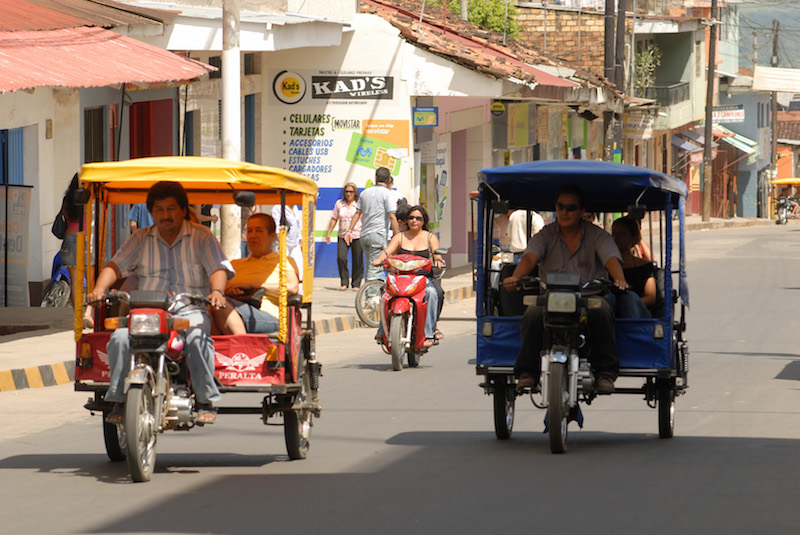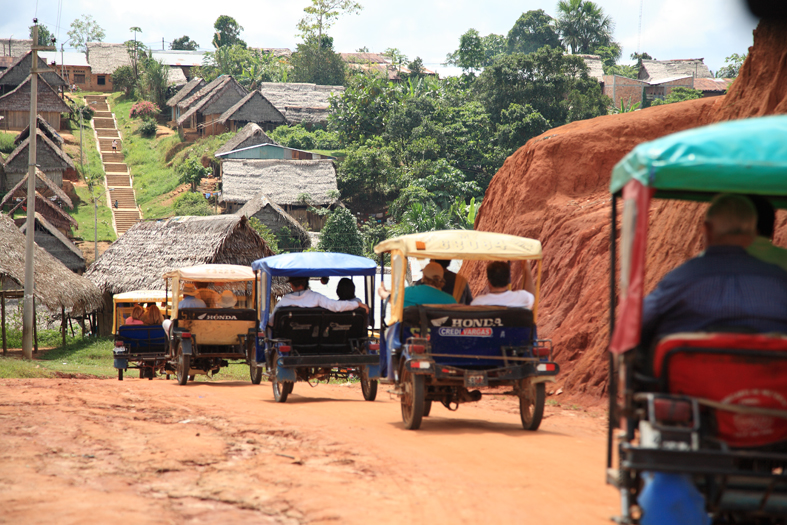A brief history of the mototaxi in Peru's Amazon region.
The pros and cons of their proliferation.
When thinking of movement in Amazonia, river transport probably comes to mind. Being home to the longest river in the world, with countless tributaries, it is certainly true that a myriad of boats - ranging from dugout canoes to narrow peke-peke speedboats to luxury cruise ships - ply the waterways, carrying people and supplies.
And yet, when you step out of the airport in Iquitos, Tarapoto, Pucallpa, or any city in Peru's Amazon, you will be struck by the sight - and sound - of another form of transport: the mototaxi, which will generally outnumber cars by at least five to one.
There are two main types of mototaxi in Peru.
In some towns, especially in the Andes, you find the small-wheeled trimovil: a three-wheeler with a more rigid, almost totally enclosed cabin. They have less room for passengers, but they offer more protection from the rain and can be converted to run on gas (which is cheaper).
The most common, however, is the converted motorcycle with the bench seat in the rear. It also has a rack behind the seat for luggage, cargo ... and occasionally further humans. When it rains - which happens pretty regularly in the Amazon rainforest region - the drivers improvise a windscreen by unfurling a clear piece of plastic attached to two strips of wood!
A trimovil in the city of Oxapampa.
Mototaxi with temporary 'windscreen' in place.
Making the most of a mototaxi's capacity.
For the inhabitants of these Amazon jungle towns, these are an economic and convenient way of negotiating the - often rudimentary - roads in and around the population centres. They can be flagged down anywhere on the street and then a price, which depends on the distance, but is rarely more than $US 2, is negotiated.
Visitors enjoying a mototaxi ride in Iquitos.
Their basic engineering means they are easy to repair; and their small size and motorbike steering makes them highly manoeuvrable ... although they do not have a reverse: if a mototaxi needs to go backwards, the driver has to get out and push!
They are certainly not a uniquely Peruvian phenomenon, as many travellers will have come across very similar vehicles in South and South East Asia, such as the famous tuk-tuk of Thailand.
In fact, when mototaxis first started appearing in the Amazon regions of Peru during the 1980s, they mostly came from India, where the auto-rickshaw was commonplace.
But once the mototaxis spread from the jungle to Lima and the Peruvian coast, during the 1990s, they took on an iconic status, to be found in nearly all towns and cities.
Nonetheless, cities in Peru's high and low Amazon, still boast the highest number of mototaxis per person.
A herd of mototaxis in Taropoto.
For all their convenience, mototaxis are not without their naysayers. The drivers have a reputation for, let's say, not adhering religiously to the Highway Code.
Combined with the flimsy, exposed nature of the vehicle itself, and the lack of seat belts, this raises a number of safety issues, especially if sharing road space with cars and trucks.
Moreover, mototaxis are polluters. The unmuffled sound of their motorbike engines can be deafening, especially when multiple mototaxis are accelerating away from a traffic light, and provides an unwelcome soundtrack to a stay in an Amazon city.
And the fuel used by most still contains lead (tetraethyl lead), which has been banned worldwide for its detrimental effects on health and the environment.
Nonetheless, a ride in the back of a mototaxi through Amazonian scenery, be it urban or rural, is an exhilarating and authentic slice of Peruvian life.
A mototaxi convoy through Indiana, near Ceiba Tops jungle lodge.








